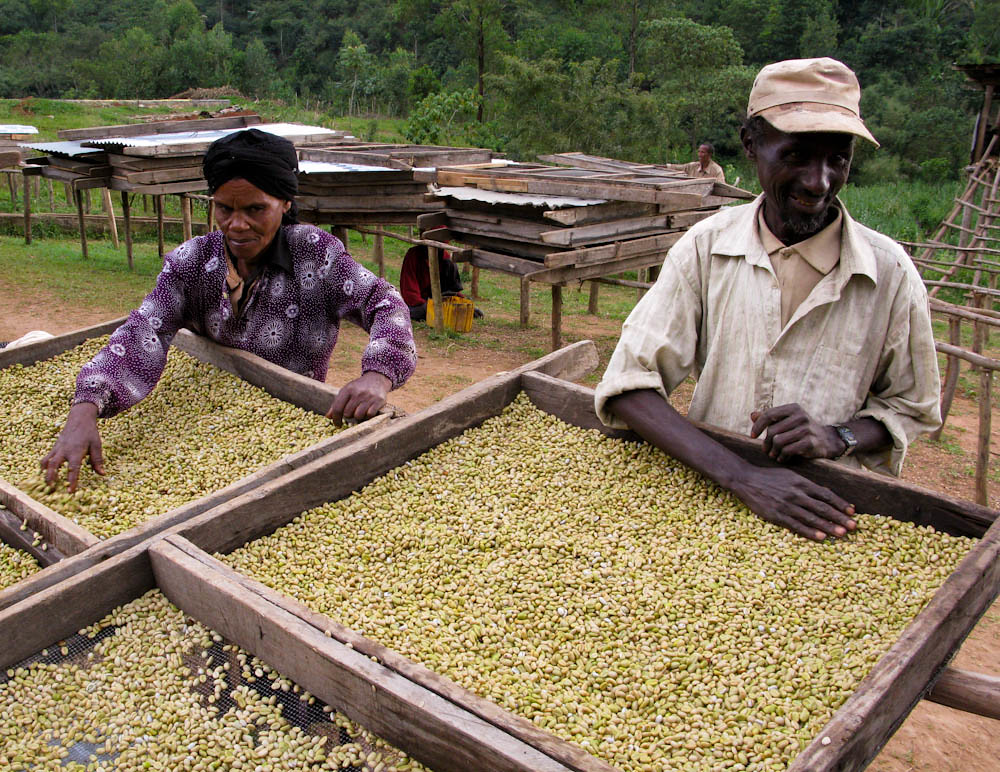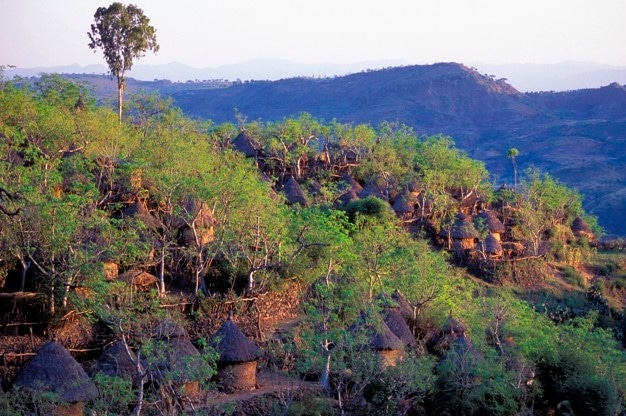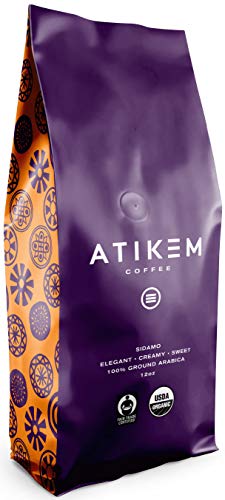Complex and, smooth, Well-balanced, Ethiopian Sidamo is one of the best characteristics of African coffee. Also considered one of the finest coffees globally, Ethiopian Sidamo can enjoy both hot and iced and is worth looking for.
Table Of Contents
−Sidamo coffee facts
- Country of Origin – Ethiopia
- Best-known producers – Sidama Coffee Farmers Cooperative Union
- Regions – Kaffa, Sidamo Ethiopia
- Altitude – 1,500 to 2,200 meters
- Body – mild
- Harvest – October to January
- Aroma – sweet, winey, floral
- Flavor – super sweet, creamy, earthy with almonds and blueberries
- Acidity – complex yet balanced, medium
- Coffee Process – washed, sun-dried
- Certification – Rainforest Alliance and Fair Trade, USDA Organic available.

Ethiopian Sidamo vs Yirgacheffe
Ethiopian coffees are frequently labeled as Sidamo. Sidamo is a large coffee-growing region in southern Ethiopia, and Yirgacheffe is a small sub-region centered on the same-named village. Yirgacheffe coffees are, in fact, Sidamos.

History

These beans are cultivated in the southern region in what used to be called the province of Sidamo. This region is also seen as the birthplace of coffee production. According to local legend, a young herder called Kaldi saw his flock become vibrant after consuming some strange red berries.
He felt a massive rush of energy after trying the berries himself. Kaldi had just found some coffee beans. Although this tale’s validity is doubtful, the hypothesis that coffee originated in Africa will likely be founded on the proof. Coffee beans have been cultivated in the area for centuries and are considered some of the finest in the world.
Farming
Sidamo green coffee is grown in the Sidamo Province of the Ethiopian Highlands between 1500 to 2200 meters above sea level and harvested between October and January. Due to higher altitudes, the growth of beans is sluggish. Although this slows production, slower growth helps beans consume more soil nutrients and produce a more complex and robust flavor profile.

Growing regions
The coffee from the Sidamo region of Ethiopia is renowned for its quality and flavor. It is grown primarily in the highlands of the Rift Valley at an elevation between 1,500 and 2,200 meters above sea level. These areas are known for their fertile soil and ideal climatic conditions that support the production of some of the world’s best coffees.
While Yirgacheffe, Kaffa, Harrar, and Djimmah are renowned areas for producing coffee in Ethiopia, Sidamo stands out as one of the three trademarked regions. The unique flavor profile that comes with Ethiopian Sidamo coffee is thanks to this ideal growing environment.
Ethiopia’s Sidamo coffees are popular for their rich body that is very nuanced, along with a bright and vibrant aftertaste that is reasonably consistent from season to season, making it a favorite Ethiopian coffee for any coffee roaster.
Coffee is a crucial component of Ethiopian culture and is celebrated daily at the traditional coffee ceremony. If you’d like to know more about the roots of coffee in Ethiopia, you can read the fascinating story of the World’s Best Coffee History.
Since the first coffee discovery, Ethiopia has produced some of the world’s finest premium coffee, spicy and complex, with a sweet winey taste and a wild acidity.
Among the most exquisite Ethiopian coffees are the fragrant and spicy Yirgacheffes, which beam with citrus tones and deliver a delicate body coupled with a lovely taste and fruity sweetness of aroma.
Ethiopian Harrar coffees – respected for their strong body and spicy aroma – are also one of the finest specialty coffees in the world, including Shortberry (including smaller coffee beans), Longberry (made up of the largest coffee beans), and Mocha (Moka; Mocca), made up of the finest peaberry coffee beans.
The Harrars are vibrant in a cup with aromatic and fruity notes of acidity and unique winey tones. The spicy and heady aroma is also followed by hints of blackberries and spices such as cinnamon, cardamom, and compote, contributing to the residual aftertaste.
Production process
Once selected, the Sidamo beans are wet-processed. Coffee cherries are pushed through a filter with a high water pressure rate. Forcing the cherries through the screen extracts much of the fruit and skin, with just a small amount of pulp remaining. The beans are then left to ferment for about a day in the tanks. The beans are removed, cleaned, washed, and left to dry in the sun. When it is dry, the remaining pulp is stripped off.
Sidamo coffee is sourced from smallholder farmers from the southern part of Ethiopia and is certified by Fairtrade and Rainforest Alliance, among other certifications. These certifications ensure that the farmers are paid fairly for their work and that sustainable farming practices are used to protect the environment. The beans are then exported to other countries for roasting and brewing.
By sourcing Sidamo coffee from Ethiopia, customers can be sure that they are getting quality-sourced beans with a unique flavor profile while supporting sustainable farming practices and fair wages for Ethiopian farmers.

Flavor Profile of Sidamo Coffee
Sidamo coffee is known for its unique flavor profile. This coffee has an aroma of honeysuckle, with tasting notes of stone fruit, jasmine, and citrus. It is known for its lemony acidity and full body, making it an exceptional cup.
When you taste it, expect good notes of tart berries, lemon, and cane sugar. Where Sidamo varies from Yirgacheffe, there is a marked earthiness. The coffee has a medium body and low acidity, and the finish is bright.
The unique flavors of this coffee are due to the natural organic grade 3 coffee grown in the Sidamo region of Ethiopia, which is at an altitude of 2,000 to 2,200 meters above sea level.
To maximize the flavor profile of Sidamo coffee, it is recommended to use medium or light roasting techniques. Doing so will retain the delicate flavor notes, and the end product will be a truly special cup.
Pairing of food

As a general rule of thumb, African coffee matches incredibly best with fruit. Citrus fruit, in particular, can bring out the dynamic notes of this coffee. We recommend combining a fresh cup of Sidamo with lemon or citrus-type desserts. You can opt for blueberries if you do not have too much citrus.
Challenges of the Ethiopian coffee production
Climate change is a huge threat to Ethiopia’s coffee production, especially due to the rising incidence and drought. New weather conditions severely affect agriculture, which accounts for 85 percent of the population.
The 2017 report published in Nature notes that “39–59 percent of the current growing area could undergo climate change that is large enough to make it unsuitable for coffee farming in the absence of significant interventions or major factors of influence.”
Getahun says that the industry is also threatened by inadequate access to the Fairtrade sector, poor implementation of lack of income diversification, good agricultural practices, lack of market information, and high production costs, among other issues.
He says, “Unsustainable consumption is a struggle for farmers to cover the cost of sustainable production. The new market players are selling less than US $1 per pound of ethically grown coffee.
Subsequently, this prohibits consumers and importers from ethically sourcing. Fairtrade initiatives and civil society are working actively to improve customer understanding of sustainability and responsible consumption.”
Andualem tells me that ‘coffee market fluctuations and other policy issues affect cooperative enterprises, and YCFCU is looking for a way to resolve them.’ This includes building roasting and grinding machines to enable producers to roast and grind their coffee.
“The new value addition project is primarily to supply our product at roasted and ground level to those corners of the entire planet that have not been tackled in our green product,” he says.
Best Sidamo coffee beans
However, I wanted to pick coffee beans labeled as Sidamo versus Yirgacheffe in this article since I would be writing another article about that smaller region.
If you prefer to roast your beans, here are Lavanta Coffee Roasters:
Grades of Ethiopian Sidamo Coffee
Ethiopian Sidamo coffee grades depend on visual inspection for defects and cup quality. There are nine grades total, with Grade 1 being the highest quality coffee. Grades 1 and 2 are strictly for specialty use, while the other grades are mainly used for commercial production.
These grades are determined by an independent government agency, ensuring the highest quality standards of Ethiopian Sidamo coffee beans. The grading process ensures that only the best beans make it into the final product. Using this grading system, Ethiopian Sidamo coffee can consistently deliver a superior taste and aroma.
Brewing Methods for Sidamo Coffee
Brewing Sidamo coffee can be a rewarding experience, as the unique flavor profile of this single-origin bean can be fully appreciated when brewed correctly. Generally, the best brewing method for Sidamo coffee is poured over, which allows the flavors to be slowly extracted from the beans.
Another popular way to brew Sidamo coffee is with a French press, which provides a full-bodied brew and intense flavors. Additionally, an espresso machine works well with Sidamo beans for those looking for a quick cup of coffee. No matter which brewing method you choose, it’s important to use freshly ground beans and high-quality water to bring out the best in your cup of Sidamo coffee.
Conclusion
In conclusion, Ethiopian Sidamo coffee is a unique, high-quality coffee with a distinct flavor profile.
This coffee can be enjoyed in many different brewing methods and provides many health benefits. Roasting this coffee to its full potential will help bring out its best flavor profile. Ultimately, Ethiopian Sidamo coffee is an excellent quality specialty-grade coffee with a unique taste experience that will delight any coffee lover.
Disclaimer: This post contains affiliate links, which means I may receive a small commission, at no extra cost to you, if you make a purchase using these links. Remember to support us by purchasing through the Amazon/Walmart/Impact Radius links provided. Last update on 2024-04-25 / Affiliate links / Images from Amazon Product Advertising API
Disclosure: No compensation or free products were received in exchange for writing this review.

Editorial Staff
The editorial staff at Crazy Coffee Crave is a team of coffee enthusiasts & Baristas who enjoy the one thing we all think about as soon as we get up in the morning. Trusted by thousands of readers worldwide.









